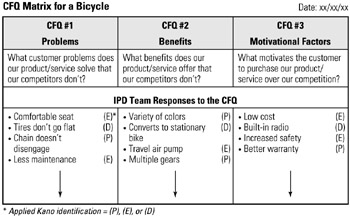Tool 55: Customer-First Questions (CFQ)
| AKA | N/A |
| Classification | Data Collecting (DC) |
Tool description
First introduced by Hewlett-Packard, the customer-first questions tool is used by integrated product development teams (IPDT) to predict a customer's reaction to a new product or service. Early data collection in the customer-research process is quite difficult because customers often cannot state their needs; they may not know enough about the product/service to assist, or they simply do not recognize existing gaps or problems. Data collection methodology is helpful as a first step in reducing the risk involved in anticipating customer needs and wants.
Typical application
-
To identify customer needs and wants and input this data into the product innovation process.
-
To respond to CFQ with additional data, product features that, from the customers point of view, are, as categorized in the matrix, presumed, expected, or delighted.
-
To reduce the risk of predicting what exactly the customers expectations are.
-
To reduce the number of product design changes during the development process.
Problem-solving phase
| Select and define problem or opportunity | |
| → | Identify and analyze causes or potential change |
| → | Develop and plan possible solutions or change |
| Implement and evaluate solution or change | |
| Measure and report solution or change results | |
| Recognize and reward team efforts |
Typically used by
| 1 | Research/statistics |
| 4 | Creativity/innovation |
| Engineering | |
| Project management | |
| Manufacturing | |
| 3 | Marketing/sales |
| Administration/documentation | |
| Servicing/support | |
| 2 | Customer/quality metrics |
| Change management |
before
-
Data Collection Strategy
-
Benchmarking
-
Thematic Content Analysis
-
Customer Needs Table
-
Morphological Analysis
after
-
Conjoint Analysis
-
House of Quality
-
Focus Group
-
Surveying
-
Customer Satisfaction Analysis (CSA)
Notes and key points
-
A response to CFQ can come from two approaches:
-
Broad customer research utilizing various data collection tools for customer input.
-
Less customer research, but an increased emphasis on a more flexible, robust design, with possible misuse of product considerations designed into the product to lessen the potential for ongoing engineering changes.
-
-
The CFQ methodology described has been adapted, modified, and used by many companies. The process has been, in this example, expanded to include the Kano model (see Step 5) as well.
Step-by-step procedure
-
STEP 1 The first step requires an integrated product development team to brainstorm possible data-collection methodologies and to develop instrumentation to answer these questions:
-
What customer problems does our product/service solve that our competitors do not?
-
What benefits does our product/service offer that our competitors do not?
-
What motivates the customer to purchase our product/service over that of our competitors?
-
-
STEP 2 Next, a CFQ matrix is created with the above questions placed in the top half of the matrix. See example CFQ Matrix for a Bicycle.
-
STEP 3 Data is collected utilizing methodologies such as benchmarking, survey, focus group, quality function deployment (QFD), or customer satisfaction analysis (CSA).
-
STEP 4 A careful check of data is completed and responses to CFQ questions are formulated. The responses are then recorded in the bottom half of the matrix.
-
STEP 5 Now apply the Kano model. To do this, the team assumes the role of the customer and categorizes the product's/service's features as belonging to any of the categories listed below. (For our purposes, the "model" is not a graph or other visual; it is merely a way to categorize and label information for easy reference.) After the features have been identified this way, label them on the matrix by placing a (P), (E), or (D) in the columns to the right of the features.
-
(P) Presumed—Features customers assume the product/service will have.
-
(E) Expected—Features customers expect such a new product/service to have.
-
(D) Delighted—Features customer do not expect. These are what really "sell" the customer.
-
-
STEP 6 A program check is necessary at this stage. If a lack of data is obvious, more research needs to be done.
Note: The integrated product development team may choose to make design changes to the product or service after completing this exercise. Remember that such changes will be small in comparison to the benefits derived from increased customer satisfaction.
Example of tool application
CFQ Matrix for a Bicycle

EAN: 2147483647
Pages: 326